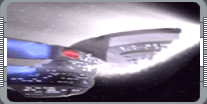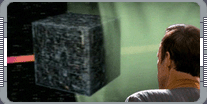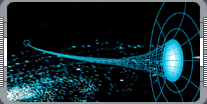
Transwarp Corridors
Transwarp refers to a method of faster-than-light propulsion that has so far been beyond Federation
scientists.
 Federation starships use warp drive, and can achieve speeds in the range of warp 9.96. This velocity translates
into approximately 3,000 times the speed of light, but, in principle, even higher velocities are attainable.
These can be achieved by using a more efficient warp drive, or by distorting subspace - a method of propulsion
dubbed 'transwarp' by Starfleet scientists. The way transwarp works can be thought of as being analogous to a
wormhole. A wormhole is a distortion of the space-time continuum such that two widely separated regions become
close. A transwarp conduit is exactly the same, only, instead of space-time being distorted, it is subspace
which is folded over on itself. In order to penetrate subspace and open a conduit from normal space, special
particles known as tachyons need to be produced. Once the correct frequency of tachyons has been found, a rift
from normal space opens through to subspace, thus creating a transwarp conduit. The flow of subspace energy
into this rift is so great that anything close by is dragged in and acclerated to extreme speeds, in the same
way that a stick that falls into a river is swept along by the current.
Federation starships use warp drive, and can achieve speeds in the range of warp 9.96. This velocity translates
into approximately 3,000 times the speed of light, but, in principle, even higher velocities are attainable.
These can be achieved by using a more efficient warp drive, or by distorting subspace - a method of propulsion
dubbed 'transwarp' by Starfleet scientists. The way transwarp works can be thought of as being analogous to a
wormhole. A wormhole is a distortion of the space-time continuum such that two widely separated regions become
close. A transwarp conduit is exactly the same, only, instead of space-time being distorted, it is subspace
which is folded over on itself. In order to penetrate subspace and open a conduit from normal space, special
particles known as tachyons need to be produced. Once the correct frequency of tachyons has been found, a rift
from normal space opens through to subspace, thus creating a transwarp conduit. The flow of subspace energy
into this rift is so great that anything close by is dragged in and acclerated to extreme speeds, in the same
way that a stick that falls into a river is swept along by the current.
Transwarp, therefore, refers to a velocity just short of warp 10. However, how to control the point of exit
from transwarp back into normal space is a mystery to the Federation's scientists. Starfleet's first attempts
at putting transwarp theory into practice occurred in 2284 when the experimental starship, the
USS Excelsior NX-2000 was commissioned. Unfortunately these
experiments ultimately proved fruitless and the project was abandoned.
 In 2369, however, the USS Enterprise NCC-1701-D witnessed the use
of a transwarp conduit while in pursuit of a marauding Borg vessel. The Enterprise found that it could activate
an existing Borg transwarp conduit and use it by emitting a tachyon pulse. Inside the conduit the Enterprise
discovered that subspace was altered to such a degree that normal space distances spanning hundreds of light
years were drastically reduced. This method of propulsion allowed the Borg ship to travel at least 20 times
faster than Starfleet ships. It is now known that the Borg have a huge network of transwarp conduits throughout
the galaxy, although each conduit probably only remains operative for a few months before a new one has to be
created. Starfleet has felt it tactically unwise to try to use the existing conduits again in case it draws the
attention of the Borg. The USS Voyager NCC-74656 is also familiar with
Borg transwarp corridors, but even with Seven of Nine's inside knowledge they have failed to implement a reliable
method of transwarp travel. When they tried to open a subspace field, tachyon particles flooded the propulsion
system and they were forced to eject the warp core. The only time they did manage to utilize transwarp
technology safely and effectively was when they obtained a transwarp coil from a Borg ship. However, this wore
out after 20,000 light years and they have been unable to construct one of their own.
In 2369, however, the USS Enterprise NCC-1701-D witnessed the use
of a transwarp conduit while in pursuit of a marauding Borg vessel. The Enterprise found that it could activate
an existing Borg transwarp conduit and use it by emitting a tachyon pulse. Inside the conduit the Enterprise
discovered that subspace was altered to such a degree that normal space distances spanning hundreds of light
years were drastically reduced. This method of propulsion allowed the Borg ship to travel at least 20 times
faster than Starfleet ships. It is now known that the Borg have a huge network of transwarp conduits throughout
the galaxy, although each conduit probably only remains operative for a few months before a new one has to be
created. Starfleet has felt it tactically unwise to try to use the existing conduits again in case it draws the
attention of the Borg. The USS Voyager NCC-74656 is also familiar with
Borg transwarp corridors, but even with Seven of Nine's inside knowledge they have failed to implement a reliable
method of transwarp travel. When they tried to open a subspace field, tachyon particles flooded the propulsion
system and they were forced to eject the warp core. The only time they did manage to utilize transwarp
technology safely and effectively was when they obtained a transwarp coil from a Borg ship. However, this wore
out after 20,000 light years and they have been unable to construct one of their own.
 Voyager's predicament of being stranded thousands of light years from home has given the crew a certain impetus
in trying to find a faster method of propulsion. In 2372, they devised a transwarp engine that powered the
shuttlecraft Cochrane to warp 10 using a purer form of dilithium. This meant the ship was occupying every point
in the universe at once, but unfortunately these velocities were found to have dangerous side effects and the
tests were halted. Voyager has also come across another species that use transwarp, the Voth. Ironically this
reptile-like species originated from Earth, but their hostile posturing precluded any hope that they would
share their technology with the Starfleet crew. Starfleet continues to take every opportunity to study the
physics behind transwarp such as in 2374 when the USS Rubicon
NCC-72936 came across a naturally occurring subspace compression anomaly. It was hoped the phenomenon
could provide important clues in helping to develope transwarp travel, but flying into the anomaly merely
miniaturized the ship and crew. Therefore despite knowing transwarp velocities are possible, at present the
execution of the technology remains tantalizingly just out of reach for Starfleet.
Voyager's predicament of being stranded thousands of light years from home has given the crew a certain impetus
in trying to find a faster method of propulsion. In 2372, they devised a transwarp engine that powered the
shuttlecraft Cochrane to warp 10 using a purer form of dilithium. This meant the ship was occupying every point
in the universe at once, but unfortunately these velocities were found to have dangerous side effects and the
tests were halted. Voyager has also come across another species that use transwarp, the Voth. Ironically this
reptile-like species originated from Earth, but their hostile posturing precluded any hope that they would
share their technology with the Starfleet crew. Starfleet continues to take every opportunity to study the
physics behind transwarp such as in 2374 when the USS Rubicon
NCC-72936 came across a naturally occurring subspace compression anomaly. It was hoped the phenomenon
could provide important clues in helping to develope transwarp travel, but flying into the anomaly merely
miniaturized the ship and crew. Therefore despite knowing transwarp velocities are possible, at present the
execution of the technology remains tantalizingly just out of reach for Starfleet.
|
|
"PROPULSION SYSTEMS" - JUNE 2000 ISSUE 14 STAR TREK: THE MAGAZINE COPYRIGHT OF PARAMOUNT PICTURES.
|